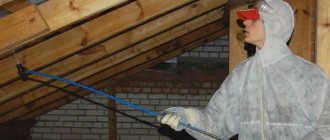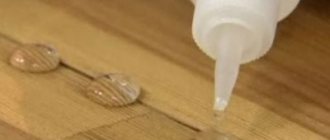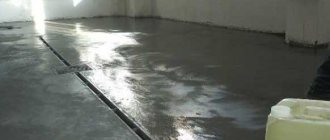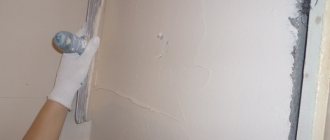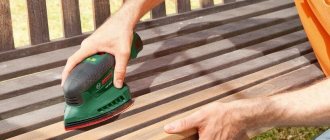Any fire-retardant coating has its own service life, during which it retains its qualities. However, after this period expires, the effectiveness of the fire retardant coating decreases, and the structures treated with it are again at risk of fire. Therefore, upon reaching the established period, fire-retardant coatings and impregnations must be checked and, if necessary, updated.
Fire retardant treatment of building structures is carried out at certain intervals. Warranty periods for fire-retardant coatings are usually indicated in the documentation for them and vary depending on the type and purpose of the coating. Fire retardant coatings for wood have a warranty period of several years, but some of them, for example, mastics and pastes, have a warranty period of up to 10 years. For metal structures, the service life of fire retardant coatings is about 20 years. If the warranty period is not established, the terms of fire retardant treatment are set to no more than 1 year. Such deadlines have been adopted since February 2014 by Decree of the Government of the Russian Federation No. 113.
Requirements for fire retardant treatment are established by relevant regulatory documents. Many business managers and private home owners are wondering who can carry out fire retardant treatment of a building. Fire retardant treatment of wooden structures, the frequency of which is quite frequent, can be carried out independently, but the work is accepted in the presence of an employee of the Ministry of Emergency Situations, who carries out quality control and signs the certificate of completion of the work. In other cases, a set of fire protection works must be carried out by specialists from a licensed organization who have the appropriate qualifications and know how to carry out fire retardant treatment professionally.
Fire retardant treatment, the frequency of which is established by the warranty period of the fire retardant coating, must be carried out on time by the head of the enterprise or the owner of the premises, who is responsible for fire safety. He checks the integrity of fire-retardant coatings and the state of fire-retardant impregnation of wooden structures, then draws up a protocol for checking the state of fire-retardant treatment. If damage is detected, they are eliminated until the integrity of the fire retardant layer is restored; if necessary, re-coating or impregnation is carried out.
Methods of fire protection of wooden structures
Fire-fighting treatment of wooden structures with a fire retardant compound (FR) has levels of effectiveness. When applying, take into account the characteristics of the wood and the building.
- disadvantages: outdated method, labor intensive, unaesthetic appearance of “scabs”, delamination, cracks;
- Pros: reliability, durability. Used for partitions with shingles, attics, basements. More often - for industrial buildings, rafters, warehouses.
- asbestos-cement sheets, non-flammable plasterboard (GVL, GKL), stone, decorative brick, tiles (ceramic, porcelain stoneware), rolled foil materials, basalt wool;
- pros: designer finishing options, reliability, durability, strength;
- disadvantages: high price, heavy weight, labor intensive, difficult to install for complex structures, reduced volume of the object.
Who can apply fire protection to timber structures
Fire protection is required for buildings with wooden structures. Without a fire safety certificate, the building cannot be allowed to operate.
Do I need a license for fire retardant treatment?
Fire safety requirements include:
- creation of a project, calculations;
- compliance with technology;
- correct selection of fire retardant composition and methods.
Fire protection work can be done independently, but it is difficult to comply with all the requirements for the fire inspection to approve the fire protection act, so specialized organizations are involved.
In order to issue technical documents, performers must have a license from the Ministry of Emergency Situations, State Fire Service and the corresponding OKVED activity (84.25.1).
Expenses of budgetary organizations on fire protection are attributed to subarticle 225 of KOSGU.
Regulations
Fireproofing agents can be produced and used only in compliance with the regulations governing these processes. The standards cover different stages of working with fire retardant impregnations for wood, and their compliance is verified by licensed organizations.
There are also documents that describe the requirements for checking compliance with standards, tests, and the objects themselves. Prescribing general rules.
Fireproofing agents can be produced and used only in compliance with the regulations governing these processes.
Fire retardants and substances for wood
All fire protection means (FR) must have a fire safety certificate. It is necessary to check its availability upon purchase and save it in the package of documents for the processing carried out.
Types and properties of OS:
- intumescent (intumescent property) - as a rule, belong to group 1. When exposed to fire:
- pores crack, gas is released, substances for self-extinguishing;
- the non-flammable film expands 10 to 70 times, creating a voluminous, non-flammable fire-retarding coke layer;
non-intumescent - base: silicates (“liquid glass”); for external and internal work. composition: acrylic one-component intumescent. Popular. Combined with alkyd primer (for example, GF-021); water-dispersed with PVA, polymers that create emulsions. Fillers: graphite, vermiculite, minerals; moisture- and weather-resistant – epoxy OS with solvents.
- flame retardants, special additives;
- mineral salts;
- acids:
- coal;
- boric;
- phosphorus;
non-salt solutions; surfactants; dyes.
- penetrating fire retardant ability;
- creating not a film, but a non-flammable environment.
This group can include wet plaster, which is considered an outdated method, although it is often classified as a constructive method.
- create a shell;
- block the access of oxygen;
- preliminary surface preparation is required (roughness, shingles).
- inorganic substances;
- lime (in plaster);
- binders;
- clay;
- vermiculite, mineral salts (silicates, superphosphates).
Compositions of the combined type
A complex of several fire retardants applied sequentially, for example, first a paste, then a varnish.
Funds may have additional properties:
Checking the quality of fire protection of wood structures
The wooden structure should not contain unimpregnated segments, cracks, chips, or defects. The layer must meet PPB standards. If deficiencies are found, the supervisory authority issues an order to eliminate the deficiencies and sets a date for the next inspection.
Sample wood fire treatment certificate
A fire protection certificate is issued upon completion of work based on quality control and compliance with fire safety standards. The paper contains characteristics of the mixture, the object, the work performed, as well as the dates of the procedures, the warranty period for the fire retardant treatment, links to standards, and the result.
The processing act is signed and stamped by the participants of the procedure (representatives): contractor, customer, State Fire Supervision. The document is an official confirmation of the presence of fire protection.
The service life of high-quality fire retardants is quite long. But this does not mean that structures can survive without re-treatment for 10 or more years. External factors and violations of operating conditions weaken the effect of fire protection. Therefore, the State Standard and other regulatory documents provide for a certain frequency of treating wooden structures with a fire retardant compound. The standard service life of fire-fighting materials is significantly less than the actual one.
Our company provides comprehensive fire protection of wooden structures in accordance with current requirements.
We carry out work of any volume and complexity, using equipment approved by material manufacturers and in the shortest possible time. Our completed projects
Examples of completed fire protection work
Fire protection of wooden structures in the Serebryany Bor complex in the Klinsky district
Fire protection of wooden structures Fire retardant impregnation of wooden structures Basic SNiP, GOST for fire protection of wooden structures Treatment of wooden structures with a fire retardant compound
TekhStroyGarant carried out fire protection of wooden structures in the Sports and Recreation Complex (PHC) and Congress. A large volume of laminated wood structures were treated with fire retardant compounds from the manufacturer NORT, which were coated with fire retardant varnish.
Read more >>
Fire retardant and anti-corrosion treatment in the elite residential complex Polyanka 44
Fire protection of load-bearing metal structures and anti-corrosion treatment of the construction site of a residential complex with an underground parking lot “Polyanka 44” has been completed. The reconstruction of the residential complex is being carried out by a large general contractor "CODEST". The most modern and reliable fireproof materials Promat were used.
Read more >>
Fire protection of escape routes in the European shopping center
TechStroyGarant specialists performed fire protection of escape routes (stairs) in the Victoria Secret women's clothing store (EUROPEYSKY shopping center) in Moscow. Fire retardant treatment using fire retardant acrylic paint in an organic solvent.
Read more >>
VIEW ALL PROPERTIES
IMPREGNATION
Frequency of fire retardant treatment of wooden structures
The frequency of fire retardant treatment of wooden structures is specified in the main construction and fire standards GOST, SNiP, NPB.
The manufacturer indicates the frequency of fire retardant treatment of wooden structures in the technical description of the composition. If this is not written directly, then the warranty period of the product is taken into account, after which the treatment should be repeated. For different products, the recommended frequency of treatment can vary significantly, from three times a year to once every three years.
If the manufacturer does not indicate the frequency of processing of wooden structures, a single standard applies: once a year (PPR 390, Russian Government Decree No. 113, 02/17/2014). Previously, there was a requirement to treat structures once every two years, but due to large losses from fires, the time frame was halved.
Fire protection standards
Fire retardant treatment in a private house is carried out by the owner himself. In apartment buildings and public buildings, licensed companies are responsible for it. Requirements and standards for fire retardant treatment are specified in GOSTs and SNiPs. According to GOST 16363-76, to assess the effectiveness of fire protection, the weight loss indicator during fire testing is used:
- If the weight loss is up to 9%, the fire retardant is classified in group I of fire-retardant effectiveness. The average fire resistance time of this design is 150 minutes.
- If the weight loss is up to 25%, the composition belongs to group II. This wood resists fire for an average of 90 minutes.
According to NPB 251-98, any building belongs to a certain fire protection class. For example, public buildings belong to class I. The fire retardant used for treating building structures must be of the same class as the building. The effectiveness group is indicated on the flame retardant packaging. The manufacturer is required to indicate the thickness, consumption of the composition to achieve the specified indicators, as well as the types, brands, thickness of soil and decorative materials that were used in combination with the fire retardant during certification.
Frequency of inspection of fire retardant treatment of wooden structures
The first action - both during the initial fireproofing treatment and during the next one - is an assessment of the fire condition of the object, which is given by an expert. Research is carried out in two stages:
During the test, samples are exposed to open flame.
If the sample continues to burn for more than 5 seconds after exposure has ceased, the result is considered negative. There are then three possible options:
- all results are positive;
- more than two samples failed testing;
- 1-2 samples showed negative results. In this case, samples are taken again, and now there should be twice as many samples.
Thanks to the work of our specialists, you will reduce the possibility of fires to a minimum.
Call: 8 (495) 150-5-987 and consult for free!
Fire-prevention wood processing technologies
How often are wooden structures treated with a fire retardant compound, depending on the type of product and design features?
There are several types of fire retardants:
- flame retardant impregnations. There are three technologies - deep impregnation, medium and surface. In the process of surface impregnation, the composition is sprayed onto the surface of the structure with a vacuum spray gun. For medium and deep impregnation, wooden parts are immersed in a solution of the product;
- coating with fire-resistant paints and varnishes. These are intumescent paints and varnishes. They are applied to the surface by air spraying or with hand tools;
- pastes, putties. Coating with these compounds is most often used in industrial premises. Not least because the finished coating does not look very aesthetically pleasing (unlike paint or varnish).
Obviously, the frequency of fire retardant treatment of wooden structures using the method of deep and medium impregnation cannot be the same as for the surface application of fire retardant, paste, paintwork materials: this procedure requires dismantling the structure, which is not always possible.
The frequency of fire retardant treatment of wooden structures using surface methods is regulated by general rules, since dismantling of structures is not required for this.
Processing order
The cost of processing is on average 50 - 100 rubles / sq. m. Preliminary stages:
- Project, calculation.
- Surface preparation:
- Cleaning up.
- Smoothing out irregularities and burrs. Some materials need to fit particularly tightly.
- Priming, putty.
- Lathing, shingles, chain-link mesh.
Degreasing.
Example of using board materials:
- Open it up.
- Mixing the glue, mixing.
- Pasting:
- Inserts for niches.
For closed profiles (rectangular pipes) no inserts are needed.
Liquid flame retardants are applied:
- With a spray gun, less often with a roller or brush. Impregnation baths are used in production conditions for the manufacture of wooden building structural elements.
- After drying, apply again - this is repeated according to the manufacturer’s instructions;
- Finish with several layers of varnish or paint.
on periodic treatment of wooden structures with fire retardant composition
The Decree of the Government of the Russian Federation No. 625 of October 25, 2006 states that only an enterprise that has received the appropriate license from the Ministry of Emergency Situations and/or fire supervision authorities has the right to carry out fire inspections and fire protection work. Based on the results of the work, this enterprise draws up an act and hands over the object to the responsible persons of the fire services. In the future, it is responsible for the quality of the fire protection performed.
“Tehstroygarant” has been in the fire-fighting services market for more than 10 years. Our license number from the Ministry of Emergency Situations is 50-B/00378 dated 02/06/2015. We also have certificates for all fireproof materials that we use in our work.
